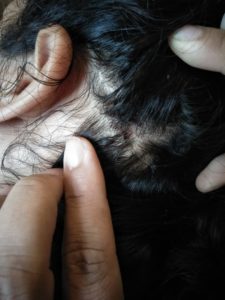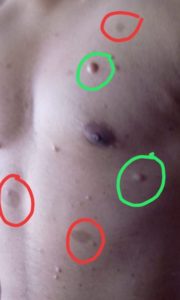Uterine fibroid is the most common benign (non cancerous) tumor that grow in the wall of the uterus.
Uterine fibroids are also known as leiomyomas or myomas. They usually form in the child bearing age of a women.
Fibroids range in size from a size of a seedling undetectable to human eye to bulky masses that can enlarge the uterus.
There can be a single firbroid to multiple ones.
LOCATION AND CLASSIFICATION OF UTERINE FIBROIDS:
Most fibroids grow on the walls of the uterus. The major classification of fibroid is as follows.,
INTRA MURAL FIBROIDS :
Intra mural fibroids are usually located within the walls of the uterus and are the most common type of fibroids. Intra mural fibroid grow as a small nodule in the muscular wall of uterus, it may expand inwards. They are asympto.atic unless they are larger in size.
SUB-MUCOSAL FIBROIDS :
Sub mucosal fibroids are located in the muscle beneath the endometrium of uterus. Even small lesions in this location may bleed.
SUB-SEROSAL FIBROIDS :
They are located on the surface of the uterus. They can grow outward from the surface and remain attached by a small piece of tissue, they are also known as pedunculated fibroid.
CERVICAL FIBROID :
Cervical fibroid are usually located at the walls of the cervix.
CAUSES OF UTERINE FIBROIDS :
Uterine fibroids are common now a days, as many as one in five women may have fibroids during thier child bearing years.
Factors which cause Fibroid are.,
AGE : Fibroids become more common as women age., especially during 30’s and 40’s. After menopause fibroids usually shrink.
FAMILY HISTORY : Having a positive history of fibroid in family increases the risk of fibroid.
HORMONAL FACTOR : During the reproductive years the oestrogen and progesterone levels are higher. These hormones stimulate the development of uterine lining, can promote the growth of uterine fibroids due to various reasons.
OTHER FACTORS
Early menarche, Use of birth control pills, Obesity.
SIGNS AND SYMPTOMS OF UTERINE FIBROID
Most women with uterine fibroids are initially asymptomatic, but some women can present with the following symptoms :
- Heavy bleeding and painful periods.
- Low back pain.
- Pressure pain or fullness in lower abdomen.
- Constipation.
- Enlarged abdomen.
- Painful intercourse.
- Frequent urination.
- Complications during pregnancy.
DIAGNOSIS OF UTERINE FIBROID
Uterine fibroids are frequently found incidently during a routine pelvic examination.
Irregularities in the shape of uterus.
Lastly most of women present with some symptoms which suggest the presence of fibroid.
HOMEOPATHIC MANAGEMENT IN TRATMENT OF UTERINE FIBROID :
Homeopathic medicines help to manage the symptoms of uterine fibroids as well as help to resolve them.
Homeopathic medicines are selected based on detailed case analysis and individualisation of the patient.
Few indicated homeopathic remedies in Uterine fibroid are :
FRAXINUS AMERICANA :
Fraxinus americana is most significant and indicated remedy in case of uterine fibroid. The patient presents with bearing down sensation in pelvis from uterine fibroid. Copious bleeding, with severe cramps and chilliness during menses.
THALASPI BURSA :
Thalaspi bursa is another indicated remedy in case of uterine fibroid. Patient presents with complaints of frequent menstruation. Violent uterine colic, cramping pain in abdomen. Low back pain during menses, menstrual bleed is profuse with presence of clots.
TRILLIUM PENDULUM :
Trillium pendulum is indicated in uterine fibroid cases with severe mentrual cramps with low back pain. The pain may radiate from back to hip. Profuse intermenstrual bleeding. Bleeding every 2 weeks.
CALCAREA CARBONICA :
Indicated in case of uterine fibroids. Usually suited to women who are over weight, fair flabby, menses are profuse due to uterine fibroid. Great chilliness. Vertigo during menses. Severe pain in abdomen and back.
SABINA OFFICINALIS :
Sabina is indicated in uterine fibroids, profuse menstrual bleeding along with clots. Slight motion increases menstrual bleeding. Pain from saccrum to pubis. Pain better by lying on the back. Pain may extend to the thighs.
USTILAGO:
Indicated in uterine fibroid where menstrual bleeding is dark red, clots are usually present. Uterine bleeding is stringy in nature. Pain in lower back and abdomen.
SEPIA:
Indicated in case of uterine fibroids. Griping , bearing down pains during menses. Menses start early and are copious. Fainting spells and chilliness during menses. Indicated in painful intercourse in uterine fibroid cases.
FERRUM METALLICUM: Indicated remedy for fibroid in uterus which result in anaemia from excessive menstrual flow.
Pale watery uterine bleed. Labour like pains in abdomen and back. Weakness and fatigue present.
AMMONIUM CARB:
Indicated in case of fibroid uterus. Profuse menstrual flow, blood looks black in colour and clotted. Extreme pain in abdomen and back radiating to thigh.
ERIGERON CANADENSIS:
Indicated remedy in case of fibroid uterus. Indicated mostly for frequent urination , with severe pain. Excessive menstrual bleed which is bright red in colour.















